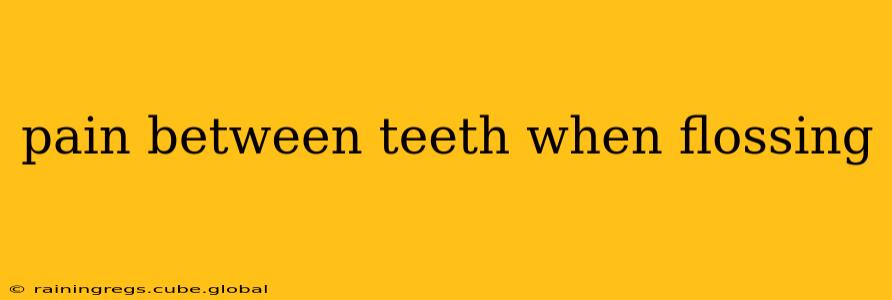Flossing is crucial for maintaining good oral hygiene, yet many experience pain between their teeth while doing so. This discomfort can be a sign of several underlying issues, ranging from simple gum irritation to more serious dental problems. Understanding the causes of this pain is the first step towards finding relief and preventing future occurrences. This comprehensive guide will explore the various reasons behind this common complaint and offer practical solutions.
Why Does It Hurt to Floss?
Pain when flossing often stems from improper flossing technique or underlying dental conditions. Let's delve into the most common causes:
1. Gingivitis and Gum Inflammation:
This is perhaps the most frequent culprit. Gingivitis, the early stage of gum disease, causes inflammation and swelling of the gums. When the floss rubs against these inflamed tissues, it naturally leads to pain and bleeding. The gums become sensitive, making even gentle flossing uncomfortable.
2. Aggressive Flossing Technique:
Using too much force while flossing can damage gum tissue and cause pain. The floss should gently glide between the teeth, not aggressively scrape against the gums. Over-zealous flossing can lead to gum recession, exposing the tooth roots and increasing sensitivity.
3. Improper Flossing Technique:
Incorrect flossing technique can also contribute to pain. Snapping the floss between teeth instead of guiding it gently can cause trauma to the gums. Failing to curve the floss around each tooth, ensuring thorough cleaning, can leave plaque behind, leading to further inflammation.
4. Cavities and Tooth Decay:
Pain between teeth while flossing may indicate the presence of cavities or tooth decay. The floss may catch on the decayed areas, causing discomfort and even bleeding. This pain is often sharp and localized to a specific area.
5. Gum Recession:
As mentioned earlier, gum recession exposes the sensitive tooth roots, making flossing painful. This condition is often associated with aggressive brushing, gum disease, or genetics.
6. Recent Dental Work:
Following procedures like fillings, extractions, or periodontal surgery, the gums might be sensitive and tender, making flossing uncomfortable. Gentle flossing is crucial during the healing process.
7. Orthodontic Appliances:
Braces, retainers, or other orthodontic appliances can make flossing more challenging and potentially painful. The appliances may obstruct access to the interdental spaces, causing irritation. Specialized floss threaders can often help in this situation.
8. Periodontal Disease:
Advanced gum disease (periodontitis) causes significant gum inflammation and damage, leading to intense pain and bleeding during flossing. This condition requires professional treatment.
What Should I Do if Flossing Hurts?
If you experience pain when flossing, don't give up completely! Here's what you can do:
- Switch to a different type of floss: Try waxed floss, Teflon-coated floss, or interdental brushes. These options may be gentler on sensitive gums.
- Use a softer flossing technique: Focus on gentle movements, carefully curving the floss around each tooth.
- Increase the frequency of flossing, but reduce the force: Flossing more frequently, but with less pressure, can help remove plaque more effectively without causing irritation.
- Consult a dentist: If the pain persists or is severe, it's essential to consult a dentist to rule out any underlying dental problems. They can diagnose the cause of your pain and provide appropriate treatment.
How to Prevent Pain While Flossing
Prevention is key to avoiding painful flossing experiences. Here are some helpful tips:
- Master the proper flossing technique: Learn the correct technique from your dentist or hygienist.
- Use the right tools: Choose floss that's comfortable for you and consider using interdental brushes or floss picks.
- Maintain good oral hygiene: Brush and floss regularly, following the recommended practices.
- Schedule regular dental checkups: Regular checkups allow for early detection and treatment of potential dental problems.
By understanding the causes of pain when flossing and adopting preventative measures, you can maintain a healthy smile and make flossing a pain-free part of your daily routine. Remember, consistent and gentle flossing is crucial for long-term oral health. If you have persistent discomfort, always seek professional dental advice.
